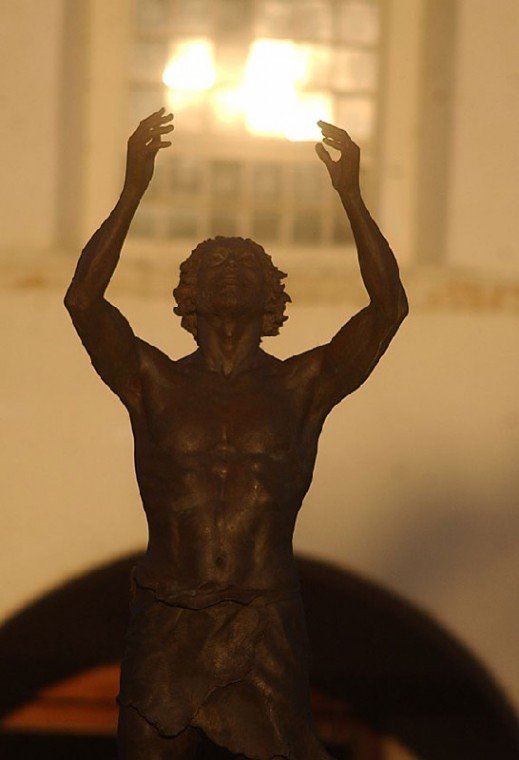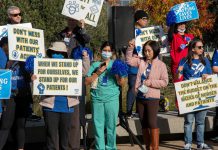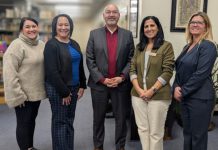The morning’s cold hangs over Mission San Juan Bautista,
piercing the darkened church and seeping into quiet nooks where
small groups of visitors ward off the pre-dawn chill with cups of
steaming coffee pressed between windchapped hands.
The morning’s cold hangs over Mission San Juan Bautista, piercing the darkened church and seeping into quiet nooks where small groups of visitors ward off the pre-dawn chill with cups of steaming coffee pressed between windchapped hands. Their faces appear from the darkness, become clear for a near moment, and flow away as if into a fog. Each one waits.
As the groups settle into the pews, a rhythmic chime begins at the front of the church. A soft voice rises above the crowd as Corralitos resident Shannon Frediani sings haunting, wordless prayers into the stillness.
In a few minutes the sun will rise, perfectly aligned with the mission to cast its blinding golden glow on the tabernacle and a statue of St. John the Baptist pointing to the Lamb of God.
For now, people begin to fidget nervously. They check their watches, make sure of the settings on their camcorders, burrow into their warm jackets and turn expectant faces toward the back of the church, willing the sun up from its hiding place.
Building on the mission began in 1803 and finished in 1812, but the Rev. Edward Fitz-Henry, the mission’s pastor, and Ruben Mendoza, a local archaeologist, believe that padres spent as many as three or four years observing the native peoples in the area before laying a stone. While many churches are built to line up with the sunrise, the mission is a bit off kilter in order to accommodate the special nature of this date.
The winter solstice marks our furthest journey from the sun, the shortest day and longest night of the year. Celebrated by societies the world over, it was called Yule by the pagans of Europe, Saturnalia by the Romans, and was incorporated as Christmas by the Christians.
A powerful symbol of rebirth, the solstice marked the return of the sun, which brought to life so much of the earth’s bounty. This fact was not lost on California’s early church builders, who designed the church to teach local populations their faith by using the sun to point toward an image of the Son.
But somewhere over history this tradition faded from view. Thus it remained until nearly 10 years ago, when a local parishioner wished to be let into the church early.
Elayna Reyna, a local artist and catholic of Native American descent, was born on the winter solstice at dawn and wanted to celebrate then. Rev. Fitz-Henry obliged, throwing open the doors just after sunrise.
“There it was, just shining on the altar and the tabernacle,” said Fitz-Henry. “The sun literally makes a path up the middle of the church, and it is beautiful.”
The discovery led to a yearly gathering. It was small at first, a handful of people, mostly Reyna’s family and friends. Now in its eighth year, the mission’s celebration attracts more than 100 people despite the inconsistent show.
“We came up last year, and it was so foggy you couldn’t even see your hand in front of your face,” said Fran Reifschneider, a retired office assistant. She decided to try again, bringing friend Barbara Espe, a Prunedale librarian, along for the ride.
“We’re batting .500,” said Thomas Marsh, a Glen Ellen resident who’s tried five times. Marsh also sculpted the tribute to the tradition, a depiction of St. John the Baptist dressed as a member of the Mutsun tribe that sits on a grassy area in front of the church. “Last year was about half of what it could be – it started out clear and then the fog rolled in right before sunrise – and 2001 and 2002 were just washes.”
It appears 2004 has been a banner year, though. As the sun crests over the mission’s eastern hills, a shaft of bright yellow light fills the aisle, and the expectant faces turn, with looks full of awe, toward the altar’s space.
Pam Church, an eighth grade teacher from Sacramento pulls her sisters, Karen Luthringer of Taylorsville, Calif. and Nancy Craney of Aromas, into the aisle to experience the bright glare.
“I just feel like this is a really special place because it sort of combines a lot of different spiritualities,” said Church. “It sort of puts us back in touch with what our roots are and celebrating that. I felt like it was a centering thing.”
Inside the church, Fitz-Henry invites attendees to walk up to the altar and experience the light. He helps the blinded men and women to climb down the steps and shuffle back to safety, while outside a song goes up to the east. Reyna and her daughter, Tori Valencia, join others from the Native American community in a Chumash song honoring their ancestors – the mother earth and father sun – calling again to the spirits from all directions and inviting them to join the celebration, for today is bathed in golden light.
The next solstice celebration will be held on Dec. 21, 2005 at sunrise.













